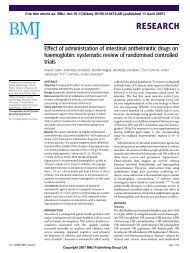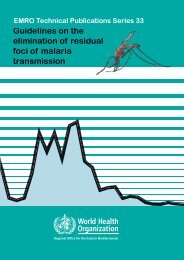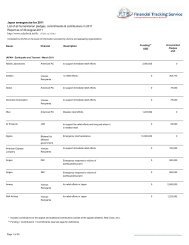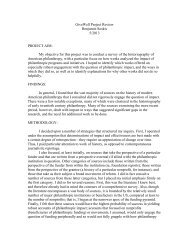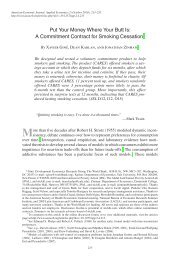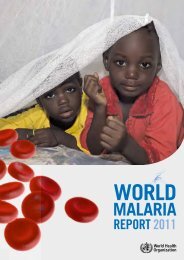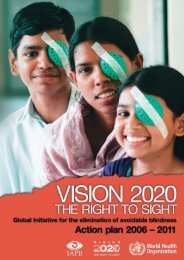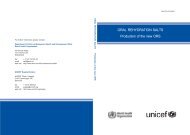Annual Report 2005 - Doctors Without Borders
Annual Report 2005 - Doctors Without Borders
Annual Report 2005 - Doctors Without Borders
Create successful ePaper yourself
Turn your PDF publications into a flip-book with our unique Google optimized e-Paper software.
<strong>2005</strong>Letter from MSFA Commitment to innovationDear Friends,With your generous support, the US section of <strong>Doctors</strong> <strong>Without</strong><strong>Borders</strong>/Médecins Sans Frontières (MSF) was able to increase ourfunding for field programs by more than 48 percent in <strong>2005</strong>. Thisallowed MSF teams, which included a record 208 aid workers fromthe United States, to provide vital medical care to people affected byconflicts and crises often ignored by political leaders and the media.Your increased support was essential for MSF to maintain itsmassive aid operation to assist victims of the conflict in theDemocratic Republic of Congo (DRC). Some 2,300 MSF field stafftreated tens of thousands of the DRC’s war-affected civilians.MSF-USA helped to raise awareness of this conflict by collaboratingwith VII, an international photo agency, to produce a photographicexhibition, “Democratic Republic of Congo: Forgotten War.” Theexhibition, which opened in New York City last year, is touring theUnited States, Africa, Asia, Australia, and Europe in 2006.MSF has been able to bring innovation to the field of independentmedical humanitarian assistance with your strong backing. AndMSF’s commitment to medical innovation—the adapting of medicaltools and protocols to better meet the needs of our patients—playeda crucial role in our response to two of the year’s biggest emergencies:the nutritional crisis in Niger and the massive earthquake in Pakistanand India.Every year many people in Niger live on the brink of starvation, butlast year the situation was even worse than usual. A poor harvestand skyrocketing food prices made it nearly impossible for hundredsof thousands of families to feed their children. MSF treated more than63,000 severely malnourished children—far more than any previousnutritional emergency—in <strong>2005</strong>.Several years ago, our teams never would have been able to handlesuch a high caseload. The traditional approach of hospitalizing allseverely malnourished children would have overwhelmed ourinpatient feeding centers. But MSF capitalized on the availability of anew ready-to-use therapeutic food—a specially formulated peanutbasedpaste which can be taken at home—to develop an innovativemedical protocol. Using this new approach, only malnourishedchildren who develop a complicating illness like pneumonia haveto be hospitalized. The rest are allowed to go home with theirmothers with a week’s supply of ready-to-use therapeutic food andthen return to an outpatient center each week for medical follow-up.The results have been impressive: not only have the numbers treatedbeen far greater, but also 90 percent of all children have been cured.These results are on par with the best-run inpatient feeding programs.MSF teams working in Sudan and other areas are now using thisoutpatient approach to treat thousands of malnourished children.MSF has published this breakthrough in medical journals and sharedour results with other humanitarian aid organizations.Your continued support has also helped MSF strengthen ouremergency response capacity with innovative new tools. Last year,MSF developed a 120-bed inflatable field hospital with a selfcontainedheating, sanitation, and water-purification system. Thishospital can be quickly deployed around the world.The need for this type of emergency field hospital became strikinglyevident in the aftermath of the October 8, <strong>2005</strong>, earthquake thatstruck India and Pakistan. Our teams reported that entire hospitalshad been destroyed. Pakistani medical personnel were being forcedto perform open-air surgery to treat complex orthopedic injuries andthen leave patients on cots laid out on hospital grounds. There wasvery little post-operative care available. MSF deployed a surgical teamand one of the inflatable hospitals to Mansehra, Pakistan, to helpimprove the quality of care there. Through this hospital, MSF surgeonscarried out more than 500 surgical interventions—many involvingcomplex orthopedic surgery—during the first two months of operation.And each week an average of 1,200 patients were seen in itsemergency room. MSF provided physical therapy to some 600 patients.Yet there is still a dearth of adapted medical tools to confront many ofthe challenges facing our medical teams and affecting millions ofpeople around the world. Tuberculosis (TB), a disease that claimstwo million lives each year, is a frightening example. The availablemedical tools are completely outdated and highly ineffective fordiagnosing and treating HIV-TB co-infection, pediatric cases, andmultidrug-resistant strains. Last year, MSF spoke out about thesestriking gaps in TB care at international conferences, in publishedopinion pieces, and through our Campaign for Access to EssentialMedicines. It will be a long battle to obtain the most adapted medicinesand diagnostics for the growing number of people living withtuberculosis, HIV/AIDS, and other diseases, but it is one that theorganization is committed to fighting.It is supporters like you who allow MSF to develop and strive forinnovative solutions to meet the needs of people trapped byconflicts, natural and man-made disasters, and epidemics. On behalfof all the MSF staff, and most importantly, the people whom we assist,we extend our deep appreciation for your trust and ongoing support.Thank you.us annual report <strong>2005</strong>Darin PortnoyPresidentNicolas de TorrentéExecutive Director




